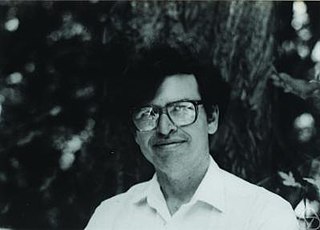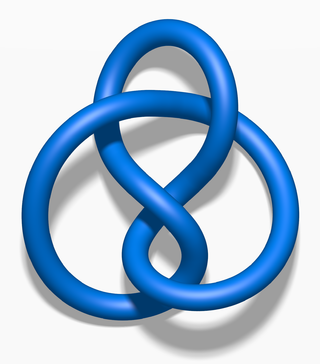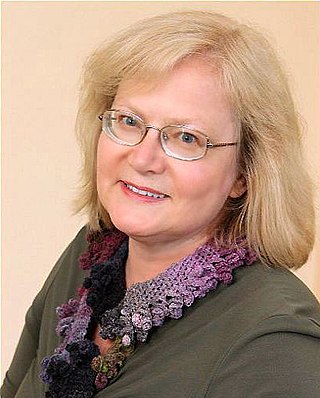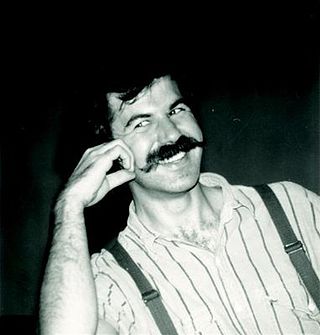
William Paul Thurston was an American mathematician. He was a pioneer in the field of low-dimensional topology and was awarded the Fields Medal in 1982 for his contributions to the study of 3-manifolds.
In geometry, a pseudosphere is a surface with constant negative Gaussian curvature.

In topology, knot theory is the study of mathematical knots. While inspired by knots which appear in daily life, such as those in shoelaces and rope, a mathematical knot differs in that the ends are joined so it cannot be undone, the simplest knot being a ring. In mathematical language, a knot is an embedding of a circle in 3-dimensional Euclidean space, . Two mathematical knots are equivalent if one can be transformed into the other via a deformation of upon itself ; these transformations correspond to manipulations of a knotted string that do not involve cutting it or passing it through itself.
In mathematics, Thurston's geometrization conjecture states that each of certain three-dimensional topological spaces has a unique geometric structure that can be associated with it. It is an analogue of the uniformization theorem for two-dimensional surfaces, which states that every simply connected Riemann surface can be given one of three geometries . In three dimensions, it is not always possible to assign a single geometry to a whole topological space. Instead, the geometrization conjecture states that every closed 3-manifold can be decomposed in a canonical way into pieces that each have one of eight types of geometric structure. The conjecture was proposed by William Thurston, and implies several other conjectures, such as the Poincaré conjecture and Thurston's elliptization conjecture.

In mathematics, hyperbolic geometry is a non-Euclidean geometry. The parallel postulate of Euclidean geometry is replaced with:

In differential topology, sphere eversion is the process of turning a sphere inside out in a three-dimensional space. Remarkably, it is possible to smoothly and continuously turn a sphere inside out in this way without cutting or tearing it or creating any crease. This is surprising, both to non-mathematicians and to those who understand regular homotopy, and can be regarded as a veridical paradox; that is something that, while being true, on first glance seems false.

In mathematics, low-dimensional topology is the branch of topology that studies manifolds, or more generally topological spaces, of four or fewer dimensions. Representative topics are the structure theory of 3-manifolds and 4-manifolds, knot theory, and braid groups. This can be regarded as a part of geometric topology. It may also be used to refer to the study of topological spaces of dimension 1, though this is more typically considered part of continuum theory.

In mathematics, a 3-manifold is a topological space that locally looks like a three-dimensional Euclidean space. A 3-manifold can be thought of as a possible shape of the universe. Just as a sphere looks like a plane to a small and close enough observer, all 3-manifolds look like our universe does to a small enough observer. This is made more precise in the definition below.
In mathematics, more precisely in topology and differential geometry, a hyperbolic 3-manifold is a manifold of dimension 3 equipped with a hyperbolic metric, that is a Riemannian metric which has all its sectional curvatures equal to −1. It is generally required that this metric be also complete: in this case the manifold can be realised as a quotient of the 3-dimensional hyperbolic space by a discrete group of isometries.

In mathematics, a hyperbolic link is a link in the 3-sphere with complement that has a complete Riemannian metric of constant negative curvature, i.e. has a hyperbolic geometry. A hyperbolic knot is a hyperbolic link with one component.
Algorithmic topology, or computational topology, is a subfield of topology with an overlap with areas of computer science, in particular, computational geometry and computational complexity theory.

Daina Taimiņa is a Latvian mathematician, retired adjunct associate professor of mathematics at Cornell University, known for developing a way of modeling hyperbolic geometry with crocheted objects.
In geometry, orbifold notation is a system, invented by the mathematician William Thurston and promoted by John Conway, for representing types of symmetry groups in two-dimensional spaces of constant curvature. The advantage of the notation is that it describes these groups in a way which indicates many of the groups' properties: in particular, it follows William Thurston in describing the orbifold obtained by taking the quotient of Euclidean space by the group under consideration.
Geometry is a branch of mathematics concerned with questions of shape, size, relative position of figures, and the properties of space. Geometry is one of the oldest mathematical sciences.

In the mathematical field of knot theory, the hyperbolic volume of a hyperbolic link is the volume of the link's complement with respect to its complete hyperbolic metric. The volume is necessarily a finite real number, and is a topological invariant of the link. As a link invariant, it was first studied by William Thurston in connection with his geometrization conjecture.

In hyperbolic geometry, a horosphere is a specific hypersurface in hyperbolic n-space. It is the boundary of a horoball, the limit of a sequence of increasing balls sharing a tangent hyperplane and its point of tangency. For n = 2 a horosphere is called a horocycle.
James W. Cannon is an American mathematician working in the areas of low-dimensional topology and geometric group theory. He was an Orson Pratt Professor of Mathematics at Brigham Young University.

Francis Bonahon is a French mathematician, specializing in low-dimensional topology.

In three-dimensional hyperbolic geometry, an ideal polyhedron is a convex polyhedron all of whose vertices are ideal points, points "at infinity" rather than interior to three-dimensional hyperbolic space. It can be defined as the convex hull of a finite set of ideal points. An ideal polyhedron has ideal polygons as its faces, meeting along lines of the hyperbolic space.










